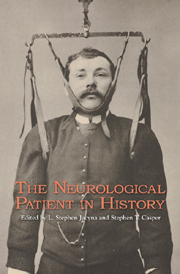Book contents
- Frontmatter
- Contents
- Preface
- Acknowledgments
- Introduction
- Part One Medicine Constructs the “Neurological Patient”
- 1 The Patient's Pitch: The Neurologist, the Tuning Fork, and Textbook Knowledge
- 2 Neurological Patients as Experimental Subjects: Epilepsy Studies in the United States
- Part Two Public and Private Constructions of the “Neurological Patient”
- Part Three Patient Groups Construct the “Neurological Patient”
- Part Four The Patient Constructs the “Neurological Patient”
- Part Five Historians Construct the “Neurological Patient”
- Bibliography
- List of Contributors
- Index
1 - The Patient's Pitch: The Neurologist, the Tuning Fork, and Textbook Knowledge
from Part One - Medicine Constructs the “Neurological Patient”
Published online by Cambridge University Press: 12 September 2012
- Frontmatter
- Contents
- Preface
- Acknowledgments
- Introduction
- Part One Medicine Constructs the “Neurological Patient”
- 1 The Patient's Pitch: The Neurologist, the Tuning Fork, and Textbook Knowledge
- 2 Neurological Patients as Experimental Subjects: Epilepsy Studies in the United States
- Part Two Public and Private Constructions of the “Neurological Patient”
- Part Three Patient Groups Construct the “Neurological Patient”
- Part Four The Patient Constructs the “Neurological Patient”
- Part Five Historians Construct the “Neurological Patient”
- Bibliography
- List of Contributors
- Index
Summary
In 1946, British neurologist and clinical neurophysiologist Gordon Holmes wrote in his Introduction to Clinical Neurology:
There is perhaps no branch in practical medicine in which the help and cooperation of the patient is so essential as in the approach to a neurological disorder. For, in the first place, it is on the patient we must mainly rely for an accurate history of the development of his illness, and such a history is often extremely valuable in determining its nature. … In the second place, many neurological symptoms are purely subjective; they are abnormalities experienced by the patient, and may be accompanied by no … visible sign of disease.
A long discussion of how a neurologist should examine a neurological patient followed this passage. Holmes, drawing upon his past practical and clinical experiences, described lessons that had reinforced his ability to determine primary, and when necessary, differential diagnoses. At the end of his volume he appended a procedural scheme that a student of neurology might employ for fact-finding on the patient's body. Intentionally or not, Holmes was addressing the challenge of translating a tacit knowledge learned through years of practice into logical, comprehensible prose for students. The appendix of his volume provided little more to the reader than the outlines of rules that structured patient-neurologist relations (fig. 1.1 and fig. 1.2). The outline was a tool; the examination of the patient, by contrast, was a practice with historically determined scientific and clinical logics.
- Type
- Chapter
- Information
- The Neurological Patient in History , pp. 21 - 43Publisher: Boydell & BrewerPrint publication year: 2012

